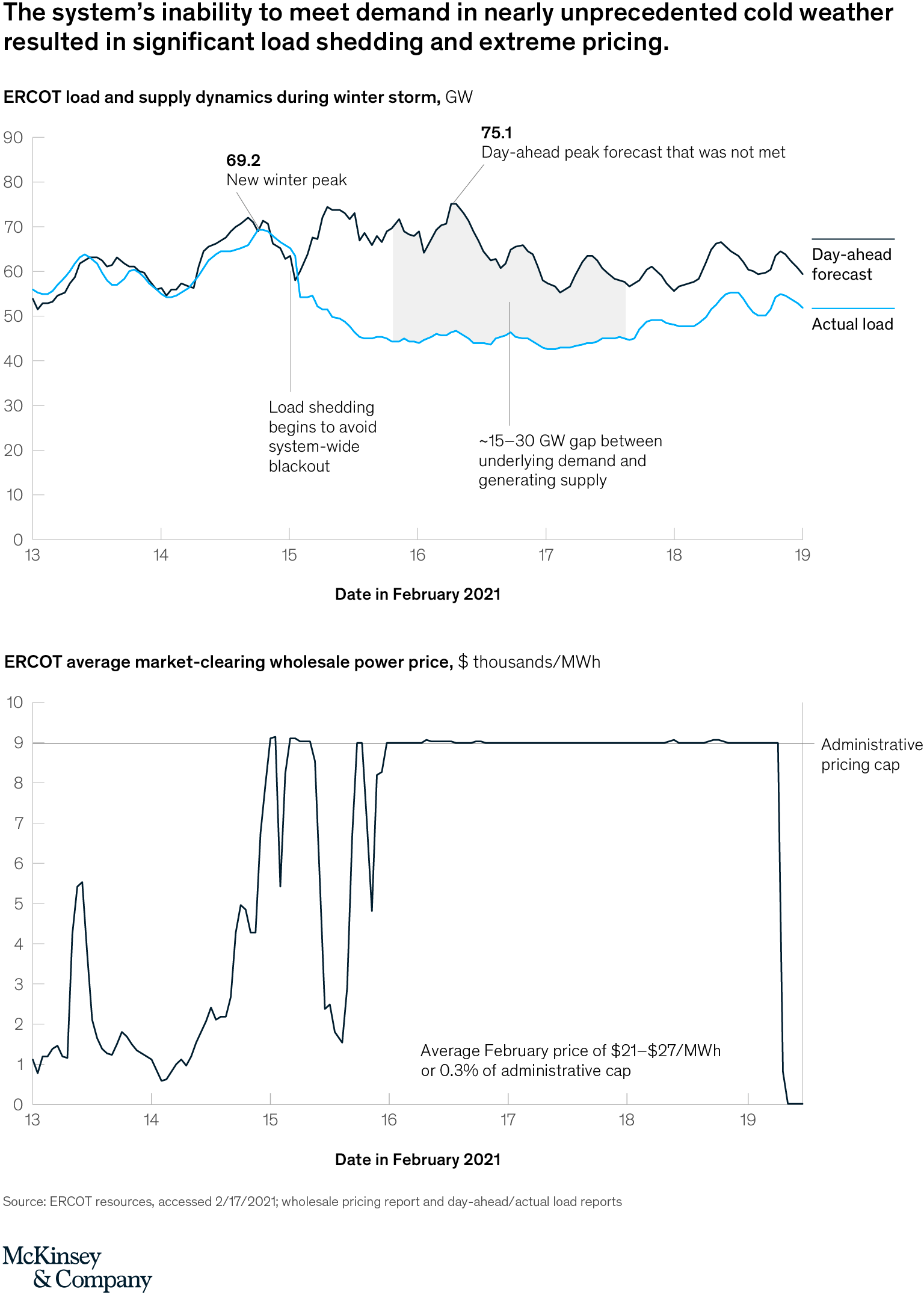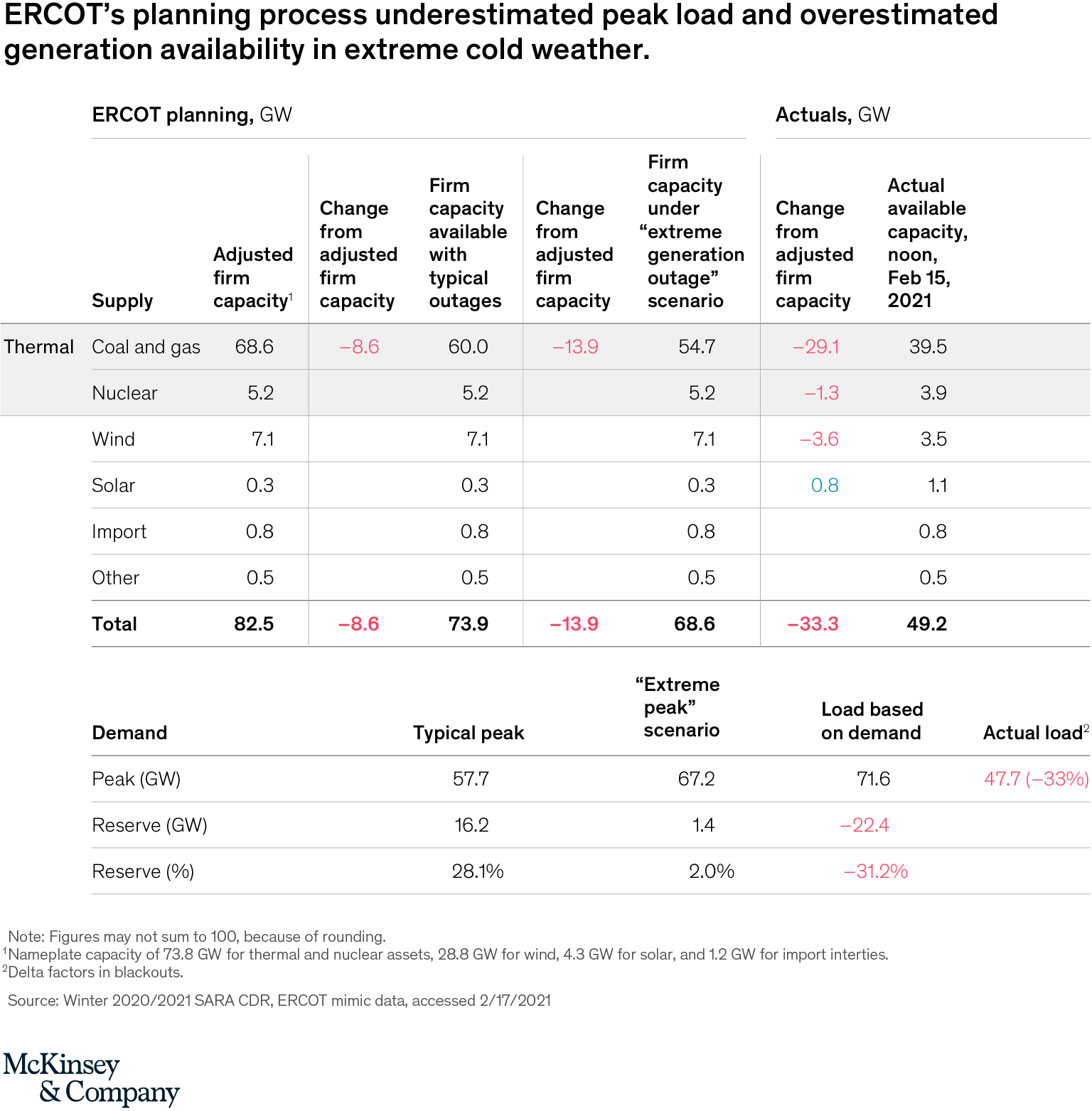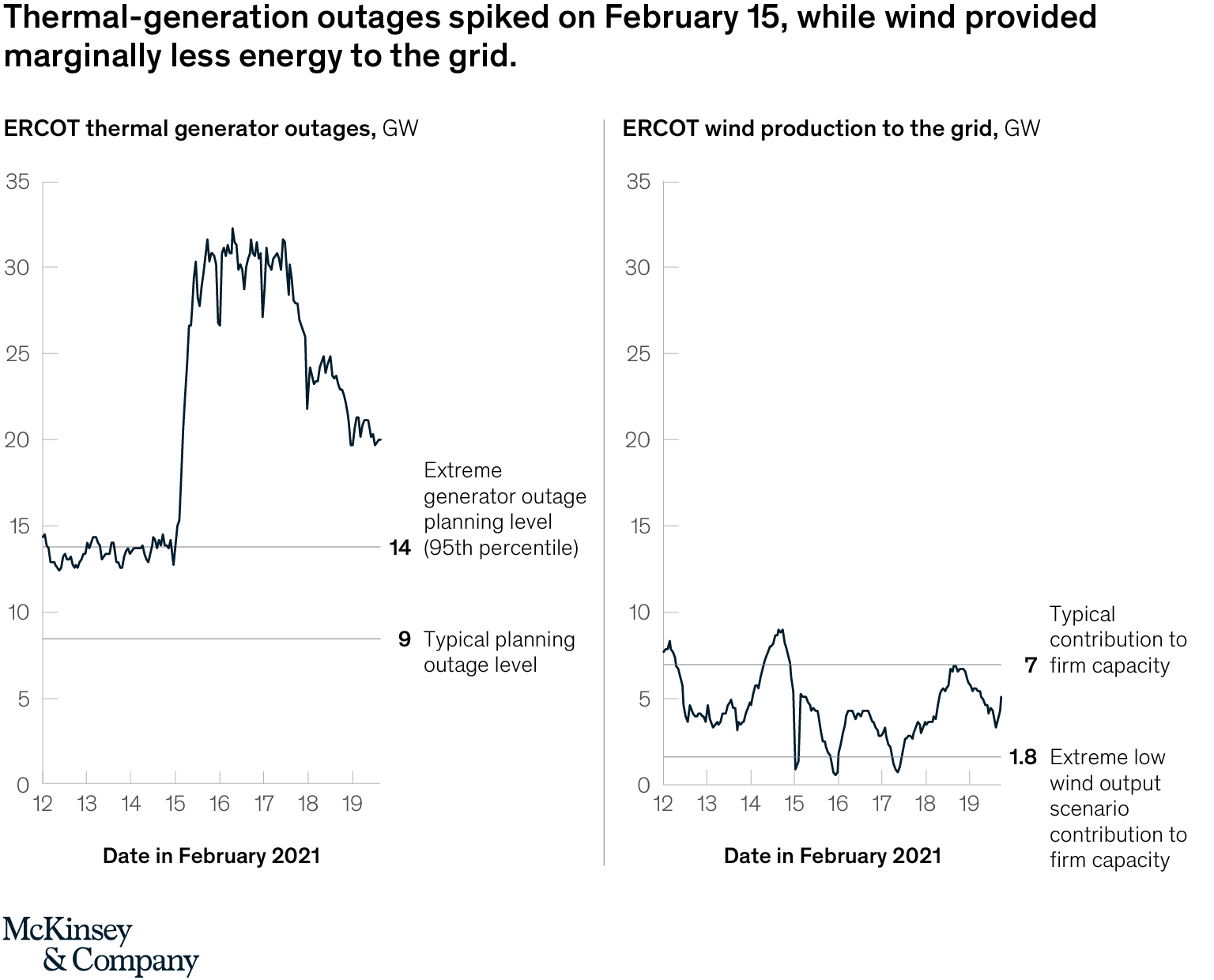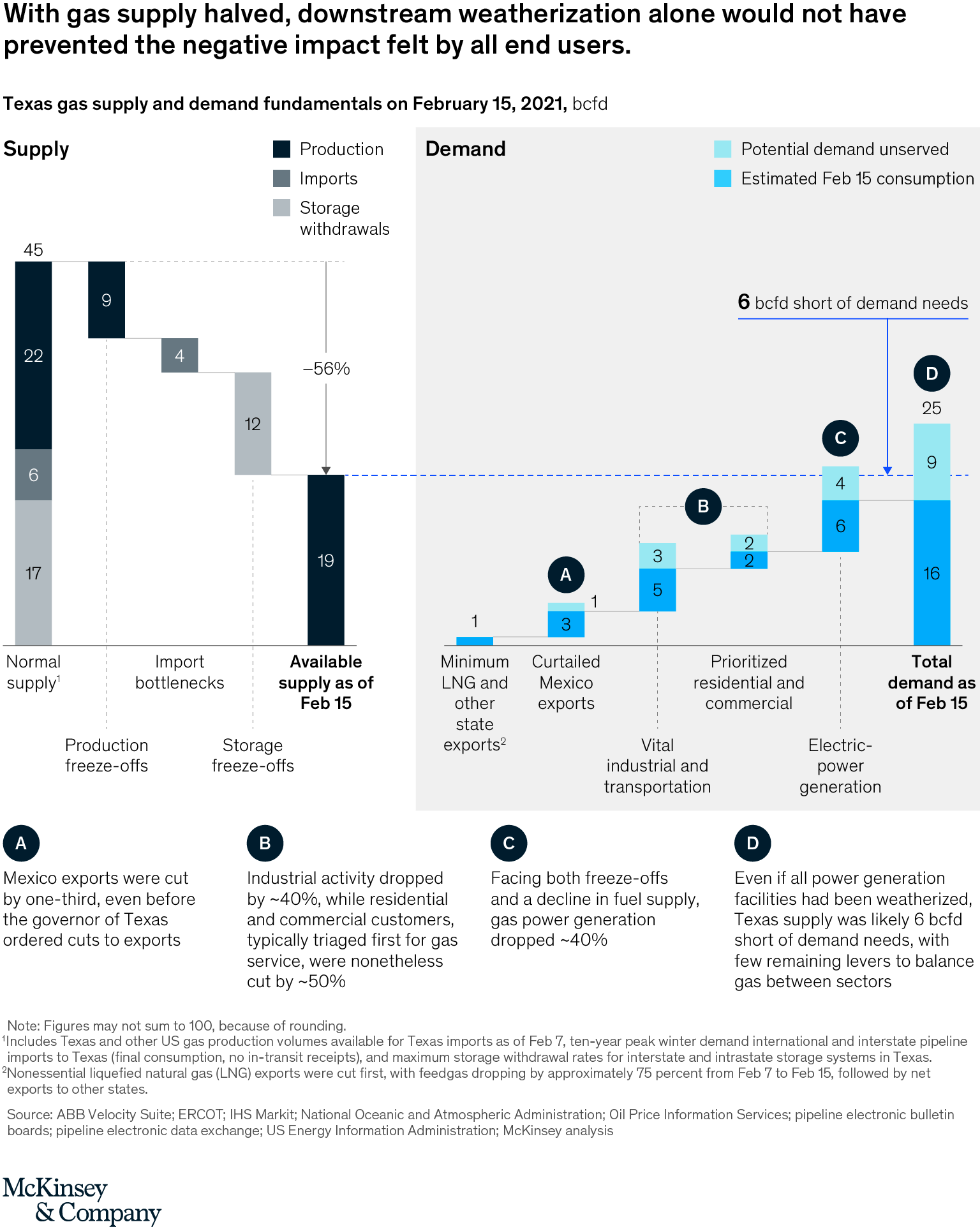At 1:25 a.m. on Monday, February 15, 2021, the Electric Reliability Council of Texas (ERCOT) issued a level-three Emergency Energy Alert, meaning energy demand was very high, and conservation was critical. By noon, more than 4.3 million homes and businesses across the state were without power (around 34 percent of total customers) and around 26 percent remained wholly without power or with “rolling” availability—systematic temporary power outages—until Wednesday.1
These events occurred during a polar vortex, which brought temperatures in Texas to lows not seen in more than 30 years and led Governor Abbott to issue a disaster declaration in all 254 counties. The results were catastrophic. To put the scale of the crisis into perspective, the International Energy Agency said that the level of power outages in Texas was more than 500 times higher than the outages in California in August 2020,2 and it’s been reported that more than 80 people have lost their lives.3
Although the implications of this event are still evolving, enough information has emerged to start to piece together precisely what happened to the generation system. More information is emerging every day, and we will provide additional insights regarding implications for the transmission and distribution system and retail market in subsequent articles.
That said, this article addresses the following key observations:
- Actual peak demand and generation outages exceeded even ERCOT's most ‘extreme’ winter peak–demand scenario. This includes both expectations for demand and generation outages. When demand exceeded supply (balance being the fundamental role of systems operators), ERCOT ordered rolling blackouts to avoid broader system failure—which was potentially just minutes away from occurring, given a drop in frequency of around 0.5 Hz.
- All power-generation sources were negatively impacted by the cold weather, with the most significant gap coming from coal and gas facilities. At times, there was more than 30 GW of thermal (coal, gas, and nuclear) capacity offline (more than 40 percent of the total thermal capacity). This was more than double ERCOT’s “extreme outage” scenario of 14 GW of thermal-capacity outages. As a point of comparison, 1.3 GW of nuclear went offline (out of a total of 5.2 GW) and wind fluctuated between 0.7 and 5.4 GW (against a base plan of 7.0 GW and an “extreme” scenario of 1.8 GW).
- Gas supply dropped by approximately 56 percent (and production in Texas dropped by approximately 40 percent). This likely means that even if all power generation facilities were weatherized and fully operational, they would not have been able to source gas adequately without ERCOT having to further shut down industrial demand or exports.
- Questions remain regarding the best combination of actions to put in place. Texas essentially has an independent power grid and cannot easily transfer electricity from another balancing authority, which makes ERCOT’s role as both an interconnection and balancing authority unique. As a result, determining the best long-term mitigating actions to put in place is a unique challenge. Questions must be asked about enhanced extreme-scenario planning—as well as about communication, incentives or mandates for weatherization and capacity, the extent of additional “tie-ins” outside of ERCOT, the next horizon of demand response, and how to ensure additional fuel supply during times of greatest need: winter and summer.
What follows is a fact-based account of what happened during those critical few days, based on the currently available data and insights (at the time of publication), as well as a series of questions that should be addressed coming out of the crisis.
What happened: Supply and demand forecasts versus actual outages
In November 2020, ERCOT published their Winter 2020/2021 Seasonal Assessment and Resource Adequacy (SARA) report,4 which outlined seasonal forecasts regarding supply and demand for the power grid.
These forecasts included a view on expected capacity (adjusted “firm” capacity and various outage scenarios) and anticipated peak demand. And while ERCOT’s extreme winter weather scenario peak planned up to 67 GW of demand, actual demand during the polar vortex peaked on the evening of February 14 at 69 GW—and could have been as high as 75 GW on February 15 if supply had been available to meet demand (Exhibit 1).

Outages were expected to be as high as 13.9 GW in an extreme-outage scenario, leaving 68.6 GW of available capacity to meet peak demand of 67.2 GW (a reserve of 1.4 GW, or approximately 2 percent of total demand). However, during the crisis, approximately 30 GW of thermal generation was not available (more than two times the amount in the extreme-generation outage scenario). This was due to a combination of factors, such as equipment or instrumentation freezing and fuel availability—particularly gas constrained by frozen infrastructure and gas diverted to priority heating loads (Exhibit 2).

Wind assets were also pushed offline due to the cold. ERCOT’s extreme-low-wind planning scenario included contributions of 1.8 GW from wind against a base expectation of 7.1 GW. As a result, through much of the week of February 15, there was an overall gap of approximately 15 to 30 GW between expected (“day-ahead”) power demand and generating supply.
At the same time (and signaling the depth of the challenge), ERCOT’s wholesale market clearing price hit the administrative cap of $9,000/MWh for 90 out of 120 hours, which is 300 to 400 times the average February price of $21 to $27/MWh. It is worth noting that ERCOT’s market was already experiencing very high pricing ($500 to $5,000/MWh) on February 13 and 14, thereby indicating that supply and demand reserves were already tightening because of the cold weather.
While all power-generation sources are being scrutinized following this incident, the two areas receiving the most attention are wind and gas.
Wind takeaways
As of February, ERCOT had 7.1 GW of adjusted firm capacity (8.6 percent of total adjusted firm capacity). Throughout the crisis, ERCOT’s wind output consistently fell below the 7.1 GW firm-capacity plan (Exhibit 3). However, for only 11 out of 120 hours (9 percent of the crisis), wind dropped below ERCOT’s extreme-low-wind-output scenario of 1.8 GW for an average of 3.9 GW (with a difference of 3.2 GW between the base scenario and actual supply). These outages are widely attributed to wind turbines freezing, as they lack heating technology that other onshore wind-generation facilities have in consistently colder climates, such as the Upper Midwest of the United States.

Gas takeaways
Thermal-generator outages due to cold weather remained at more than 30 GW for most of the crisis, significantly higher than the extreme-generator-outage-planning level of 13.9 GW. These outages were caused by a combination of both on-site issues and fuel availability. And while additional data regarding the source of these outages and root cause(s) are being collected, our analysis shows that even if all power-generation facilities were weatherized and fully operational, they likely would not have been able to source gas adequately without having to further curtail other vital residential and commercial end uses.
Using February 7 as a baseline, the gas supply in Texas on February 15 fell by approximately 56 percent—from 44.5 to 19.4 bcfd—because of freeze-offs (when cold weather disrupts gas production) and other winter disruptions (Exhibit 4). In fact, 40 percent of production losses occurred in Texas (6 bcfd from the Permian Basin and 3 bcfd from others). Meanwhile, increased demand and freeze-offs in nearby basins and pipelines disrupted imports from other states, and frozen storage facilities stalled withdrawals at approximately 5.0 bcfd until Thursday, February 18 when withdrawals hit record levels of around 16.5 bcfd.

Looking at demand sources and factoring in critical end uses, we see that gas supply would likely not have met demand even if all facilities were operating. Furthermore, it’s likely that no other fuel sources were available to balance out gas, as LNG feedgas reached near zero, and exports to Mexico were cut by a third. Thus, while much of the focus has been on potential reforms to the power-generation ecosystem, additional questions should be asked about gas supply.
Questions to address coming out of this crisis
In August 2011, the North American Electric Reliability Corporation (NERC) and the Federal Energy Regulatory Commission (FERC) jointly published a report looking at the outages that occurred in Texas earlier that winter.5 Included in the report were a number of recommendations for the electric industry and the natural-gas system, such as incorporating more extreme weather events into planning scenarios, anticipating the so-called next horizon of demand response, developing stronger interconnect tie-ins, and creating incentives or mandates to weatherize facilities.
On this last point, electric-power generators were advised to weatherize plants to perform at the lowest recorded ambient temperature for the nearest city. Natural-gas facilities in Texas and New Mexico were advised to determine whether production shortages during extreme cold weather could be effectively and economically mitigated through the adoption of minimum, uniform standards for the winterization of natural-gas production and processing.
Ten years have passed since the previous significant cold-weather crisis, and weather events of this magnitude are expected to occur more frequently in the years to come. In light of ERCOT’s unique role as an interconnection and balancing authority, as well as the Texas Railroad Commission’s jurisdiction over in-state gas supply, answering the following questions will be required to help assure suppliers, power generators, grid-asset owners, and customers that the right combination of long-term mitigating actions will be put in place at the wholesale power level.
Next steps and covering costs
- At what speed and depth will stakeholders address these most important, occasionally interrelated questions, many of which were raised in the 2011 NERC/FERC report?
- Who will pay for the changes? How much of the burden will be placed directly on generators as opposed to being distributed through ERCOT’s customers?
Plan for increasingly frequent and extreme-crisis events
- Given the differences between ERCOT’s extreme-weather scenarios and actual supply and demand, how will their planning processes evolve to account for a higher frequency and severity of climate-driven events? For example, the winter 2020/2021 SARA report evaluated peak demand “based on average weather conditions at the time of winter peak demand from 2004–2018.” How can and should plans account for one-in-50 or one-in-100-year scenarios?
- In addition, how will supply and demand needs evolve as demand patterns change (for example, as electric heating load continues to grow) and as renewable penetration increases?
Compensation mechanisms for weatherizing facilities
- How will ERCOT compensate power generators for investing in technologies that other operators have adopted in colder climates (for example, heaters on wind turbines, on-site oil storage for gas facilities, or instrumentation “hardening”)?
- Will these technologies become mandatory to operate, or will they be facilitated through more market-driven incentives?
Compensation mechanism for capacity
- Will ERCOT move to some form of compensation for capacity to ensure lower-utilization generation can remain economic—especially as fossil-fired generation will likely decrease in utilization given the recent growth in renewables?
- How will these mechanisms interact with storage incentives to ensure the right level of backup power?
Extent of additional tie-ins outside of ERCOT
- What additional interconnection opportunities does ERCOT have with the Western Electricity Coordinating Council (which accounts for two Canadian provinces, 14 western states, and northern Baja Mexico) and Eastern Interconnection (which accounts for major land masses throughout Canada and the United States)? How much would interconnection alleviate future issues?
- Would ERCOT go so far as to formally join one of these FERC-regulated markets?
Next horizon of demand response
- Should ERCOT make additional investments in demand-response options to avoid load shedding where possible? When load shedding does occur, how can they avoid such large-scale events?
Fuel-supply availability
- Given gas supply is regulated by a different body in Texas—the Railroad Commission—what role will they have in planning changes and incentivizing additional availability?
This blog post is the first in a series on how to respond to the recent power outages in Texas. Entries on the electric grid and retailing will be published as more information comes to light.
Adam Barth is a partner in McKinsey’s Houston office; Jesse Noffsinger is an associate partner in the Seattle office; and Humayun Tai is a senior partner in the New York office.
The authors wish to thank Jamie Brick, Evan Polymeneas and Kelsey Sawyer for their contributions to this article.
1 Asher Price, “ERCOT officials won’t say when power in Texas will be fully restored,” Austin American-Statesman, February 16, 2021, statesman.com.
2 Keith Everhart and Gergely Molnar, “Severe power cuts in Texas highlight energy security risks related to extreme weather events,” International Energy Agency, February 18, 2021, iea.org.
3 As of February 25, 2021. For more, see Natalie Neysa Alund, “How did at least 86 people die in Austin area during Texas freeze? It remains a mystery,” Austin American-Statesman, February 25, 2021, statesman.com.
4 Seasonal assessment of resource adequacy for the ERCOT region (SARA) winter 2020/2021, ERCOT, November 2020, ercot.com.
5 Report on outages and curtailments during the southwest cold weather event of February 1-5, 2011: Causes and recommendations, Federal Energy Regulatory Commission and the North American Electric Reliability Corporation, August 2011, ferc.gov.


